
Bringing New Micromodels to Life
Micromodel USA
by Matthew Sparks
Photographs by the author
More than a few years ago, I was traveling with my family, we were on a tour bus visiting Stratford upon Avon. I had a few pounds in my pocket. We had seen the sights and the tour bus was going to leave shortly. I was in the gift shop of Shakespeare's Birthplace looking for a souvenir I could afford. On my limited budget, I wasn't having much luck, I was about to give up and go get on the bus, when I spotted a small dusty box marked "Sale" tucked behind the door of the shop. It had just a few items in it, but the ones that caught my eye were colorful little packets of cards that could be made up into models. There were several, but being in Shakespeare country, I bought two: the Globe Theater and Anne Hathaway's cottage. Quite pleased with my souvenir hunting prowess, I got back on the bus. I really enjoyed examining the cards and envisioning the completed models, but really I had no intention of building them. Models, I knew, should be made of plastic, not paper.
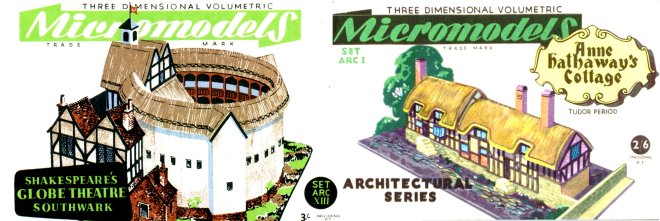
Wrappers from my Collection
The two packets were placed in my suitcase and and when I got home they were propped up on a shelf in my bedroom with a collection of other souvenirs from places we had traveled to. A few years went by and even though we moved several times, the two Micromodel packets always had a spot on my shelf. In my senior year of high-school we studied Shakespeare, and we had to do a project. The project options were many and ranged from "Write a Paper" (no way!), to "Perform a scene from one of Shakespeare's Plays" (really no way!), and there tucked at the bottom of the list of possibilities was, make a model...
I remembered right away the two packets sitting on my bedroom shelf and thought to myself, "Aha! Easy A!" I, by this time, actually had made several paper models, airship models I had bought at the gift shop in the Smithsonian Institution. So making up one of these packets wasn't going to be a problem. I chose the Globe and actually was able to put it together in just a couple of evenings. I turned the model in and got an A+, the teacher really liked the model and asked if she could keep it. I said sure.
Making the Globe was fun, so I decided to go ahead and make the cottage-
Those of you who collect Micromodels are cringing right now. But I will say in my own defense: who knew these things were actually valuable? These were the days before the Internet, and as far as I knew paper modeling was something only I did and wasn't actually something to bring up in polite company. I never had actually met someone else who ever made a paper model. It was the kind of thing plastic modelers looked down on, but I sure loved ending up with a model that I didn't have to paint!
I'd like to say I finished the Cottage and it was wonderful. but I honestly can't remember. I do remember having a real problem with getting the roof on right, I think I may have given it up as a lost cause and chucked it, or possibly I ended up giving it to the teacher also. I just can't recall. But I didn't forget the neat little cards and the colorful wrappers, though when I checked around for more I could hardly find any.
Fast forward more years than I like to admit. I'm surfing on the Internet and for whatever reason, I entered "paper model" into the AltaVista search engine, and suddenly an entire world of paper models and paper modelers, opened up before me. Soon I found Fiddlers Green, and Paper Models International, and PMI had some Micromodel reprints! They even had a small book about paper models. Then I discovered they were on eBay! Slowly I kept building my collection. I heard about Lester Harrison's monograph on Micromodels and contacted him and was able to purchase a copy. It was really interesting. If you're a Micromodel collector, this is a "must have." In the booklet on page 36 is a section about the Micromodel "Might Have Beens." It mentions that there were quite a few models mentioned in catalogs but never designed or released. I was looking back through the model listings and I found several examples. One of which was S7, SS Clermont, an early steamship. Lester mentions there was a single sketch of the model in some catalogs but it was never actually designed.
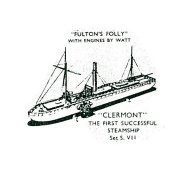
I was kind of curious why Heighway was interested in making a model of the first steamship. Most U.S. School kids had heard of Fulton and his steamship, but that seemed to me to be a quintessentially American story. I asked Lester where I could find a catalog with that picture in it. Lester was kind enough to send me a copy of the catalog with the picture. The sketch in the catalog was quite simple but cleared up the mystery. It was labeled "Fulton's Folly" with engines by Watt.
Heighway was planning to model the Clermont, to showcase the British built steam engine. I was quite taken by the little ship and really wanted to see the model in person. The only way that was going to happen was if I made it myself. So I started doing a little research. I wondered where Heighway had gotten his idea for how the Clermont looked, because as I researched the ship, I found many paintings of the Clermont, many fanciful and many plain, but none looked anything like Heighway's design. That little sketch wasn't enough for me to design the model from, at least not the way I wanted it to look. I gave the project up as a lost cause.
A couple months went by and I got an email from the Library of Congress. One of the people I had contacted during my research gave my email to someone else, who passed it along until it had reached a Librarian at the Library of Congress. She had some photographs of the Clermont - did I want to see them? Photographs? we must be taking about two different Clermonts! Actually it was; these were photos of a replica made in 1909, but I sure did want to see them. And they were gorgeous, and just what I needed to build the model. It turns out Heighway's sketch was pretty close to the replica's design. I wonder if he had access to the same photos.
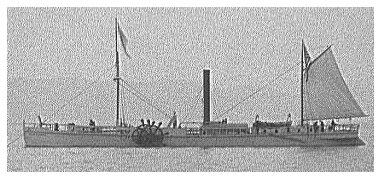
Well I designed it and made it up to look similar to a Micromodel packet, but put my own logo on it. I think it would have been very close to whatever Geoffrey Heighway had been planning. Then I went back to just collecting. Still whenever I went back and read some of Lester Harrison's Micromodel History, I would always stop at the entries, that were marked, "never released" and wonder what might have been.
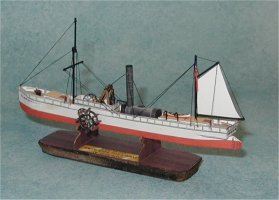
A couple more years passed, and I acquired some of the Micromodel Booklets. In the Micropution booklet, there are actually some pictures of unreleased Micromodels: for example, the two missing models in the Maori Architecture Series. I was able to acquire the unfinished sketches of one of them, The Maori Meeting House. At the same time, I got the unfinished sketches of Ludgate. I completed both models, but it turned out the copyrights of both of those models are owned by a man in England. I tried to obtain permission to distribute them, but was unsuccessful. I understand he plans to release both models himself sometime soon.
While the copyrights to those models are still held by the man in England, The North American rights to the Micromodels name and trademarks had been purchased by another person. From this person, I have acquired permission to use the Micromodels name and trademarks and release new original Micromodel designs. Having this permission is actually quite a responsibility. There are standards to uphold and maintain. Calling something a "Three Dimensional Volumetric Micromodel," means something. You have to think about what Geoffrey Heighway was planning to do and what he would have been likely to do had he not become ill and passed away. My goal is to have my models fit in with the original Micromodels. You wouldn't want to release a model that would lessen the quality of Micromodels as a whole.
My original plan was one model for each category, one architectural model, one ship model, one aviation model, one train model and one toy model. Then I realized there are actually more categories than that. I also was perplexed at the thought, which ship? Which building, Which Plane? There were so many good choices. Not just the models that were never released, what about the ones he should have done? You think of Micromodels as British, how come he never did Buckingham Palace? What about Stonehenge? or St Paul's?
The problem isn't coming up with ideas, its narrowing down the choices. I actually decided to fill in the hole in my collection first, I had all the gates now except for Temple Bar, whatever that was. So I did a little Internet searching and found out more about Temple Bar then I wanted to know. The most important thing I found out was It was the only London Gate that still existed. That meant Photographs!
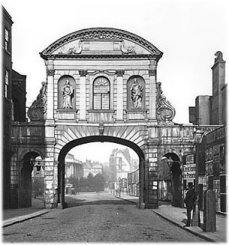
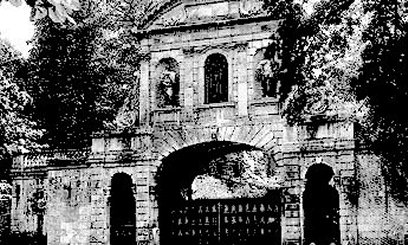
Temple Bar was originally in London on the Strand; but at the turn of the century it was moved to a private country estate. That saved it from destruction. Just this year it was moved back to downtown London. I based my model on photographs of the gate taken just before it was moved. Interesting to note that the picture on the left above is about 100 years older than the picture on the right.. Most of Heighway's Gate Models were based on larger models by a man named Thorpe. For some reason Thorpe never made a Temple Bar model; although a subsequent owner of Micromodels thought about making one some time later. It seems they even hired an artist to design a prototype wrapper, But the style of the model that was shown on the wrapper did not match the style of the other Micromodel gates and the scale was way off. The most glaring difference was that there was no background for the model. I based the buildings and the background of my Temple Bar on actual buildings in the photos of the gate. The textures of the models, the bricks, the stones were all made from photographs of brick and stone walls around Sacramento, California. It was fun looking for real masonry that matched the style of Micromodels.
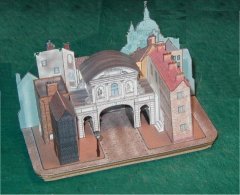
Next for a change I wanted to do something different - something that Geoffrey Heighway hadn't thought about. It still needed to be something that he might have done, though. I knew that he had been planning to release a model of a battleship, and he had released some models of World War II subjects, but most of those had been subjects from the European Theater. He had pretty much neglected the Pacific Theater. Of course as soon as I thought of the Pacific Theater of WWII, I thought of Pearl Harbor. The ship that represents Pearl Harbor to most people is the Arizona. A model of the Arizona was a natural, so I started in on it. It is nearing completion. While I was working on that model I thought, "Wouldn't an Arizona Memorial model be cool?" So I started collecting research for that too! I mentioned my plans for an Arizona Memorial Model to Dan Shippey of Delta Seven Studios and it turns out he had been working on the exact same project (although in a larger scale). Some firm cajoling and some downright begging later, and Dan agreed to design a Micromodel Arizona Memorial. He used photographs, blueprints and even satellite reconnaissance to make this incredibly accurate model. The base of the model (which shows the sunken arizona) isn't a photograph, that's actually a painting Dan did on his computer. You have to see this one in person to get the full effect.
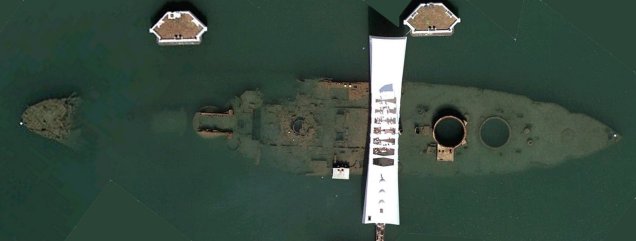
Satellite Photo

The model
Designing Micromodels has turned out to be a blast. The next model to be released will probably be Four Little Spaceships. A Mercury, Gemini, Apollo and Lunar module; you can hold all in one hand. Soon after that will be the release of the USS Arizona in the same scale as the Memorial model. We also have a couple of train models in the works. Every day brings at least one new idea for a model that would make a great Micromodel. But the you have ideas for a Micromodel you want to see, stop by our website, www.MicromodelsUSA.com number one criterion I have for a Micromodel is that I want people to like it. If and leave us feedback, or you can email me at Contactus@MicromodelsUSA.com.
